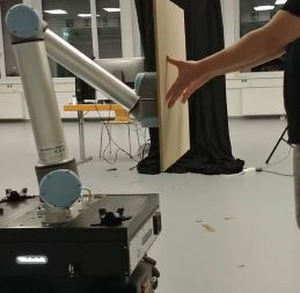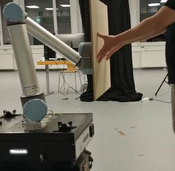Information
- Publication Type: Master Thesis
- Workgroup(s)/Project(s):
- Date: April 2021
- Date (Start): 12. April 2012
- Date (End): 10. February 2011
- TU Wien Library:
- Diploma Examination: 12. April 2012
- Open Access: yes
- First Supervisor: Hannes Kaufmann

- Pages: 111
- Keywords: virtual reality, haptics, collaborate, robot, rb-kairos, ur-10, vive, robot operating system, ros, steamvr
Abstract
After technological advancements in computer graphics and miniaturization of electric circuits, virtual reality has finally found its way into the consumer market. Commercial VR systems like HTC ’s Vive allow their wearers to experience virtual worlds realistically enough to feel audio-visually immersed. However, when interacting with the simulated environment, the limitations of such a system become apparent quickly. They o˙er no haptic capabilities or feedback beyond what is integrated in their hand-held input devices. Additional body-worn equipment, like haptic suits or exoskeletons, deliver only rudimentary haptic experiences or encumber the user’s ease of movement with excessive weight. Haptic hardware of the ‘encounter’ type are often constrained to a specific location within the simulation area or deliver only soft touching sensations because of their highly mobile but fragile architecture. Therfore, this thesis covers the topic of creating a VR system with haptic feedback and describes its design and implementation in a room sized setup. The paper shows how a mobile manipulator, like the RB-Kairos, can be combined with a virtual reality headset, like the Vive, to deliver real world props into the hands of users to enhance their virtual experience. To track the manipulator’s position with the same accuracy of the VR headset, the Vive’s Lighthouse tracking solution is integrated into the robot. On the software side, the system takes advantage of the Robot Operating System (ROS), which is already configured to control the robot’s basic functionality and is extended to include new modules handling the deliverance of haptic sensations. The simulation of the visual part of this project is handled by the gaming engine Unity, which features a variety of plugins suitable to create basic VR applications with minimal e˙ort. The communication between VR application, RB-Kairos and user is handled wirelessly via radio signals which allows unrestricted mobility for participants and robots within the simulation area. The subsequent technical evaluation o˙ers insights to operating parameters and lists potential enhancement and upgrade possibilities.
Additional Files and Images
Additional images and videos
Additional files
Weblinks
BibTeX
@mastersthesis{Sprung_2021,
title = "Mobile Collaborating Robots for Direct Haptics in Mixed
Reality",
author = "Reinhard Sprung",
year = "2021",
abstract = "After technological advancements in computer graphics and
miniaturization of electric circuits, virtual reality has
finally found its way into the consumer market. Commercial
VR systems like HTC ’s Vive allow their wearers to
experience virtual worlds realistically enough to feel
audio-visually immersed. However, when interacting with the
simulated environment, the limitations of such a system
become apparent quickly. They o˙er no haptic capabilities
or feedback beyond what is integrated in their hand-held
input devices. Additional body-worn equipment, like haptic
suits or exoskeletons, deliver only rudimentary haptic
experiences or encumber the user’s ease of movement with
excessive weight. Haptic hardware of the ‘encounter’
type are often constrained to a specific location within the
simulation area or deliver only soft touching sensations
because of their highly mobile but fragile architecture.
Therfore, this thesis covers the topic of creating a VR
system with haptic feedback and describes its design and
implementation in a room sized setup. The paper shows how a
mobile manipulator, like the RB-Kairos, can be combined with
a virtual reality headset, like the Vive, to deliver real
world props into the hands of users to enhance their virtual
experience. To track the manipulator’s position with the
same accuracy of the VR headset, the Vive’s Lighthouse
tracking solution is integrated into the robot. On the
software side, the system takes advantage of the Robot
Operating System (ROS), which is already configured to
control the robot’s basic functionality and is extended to
include new modules handling the deliverance of haptic
sensations. The simulation of the visual part of this
project is handled by the gaming engine Unity, which
features a variety of plugins suitable to create basic VR
applications with minimal e˙ort. The communication between
VR application, RB-Kairos and user is handled wirelessly via
radio signals which allows unrestricted mobility for
participants and robots within the simulation area. The
subsequent technical evaluation o˙ers insights to operating
parameters and lists potential enhancement and upgrade
possibilities.",
month = apr,
pages = "111",
address = "Favoritenstrasse 9-11/E193-02, A-1040 Vienna, Austria",
school = "Research Unit of Computer Graphics, Institute of Visual
Computing and Human-Centered Technology, Faculty of
Informatics, TU Wien",
keywords = "virtual reality, haptics, collaborate, robot, rb-kairos,
ur-10, vive, robot operating system, ros, steamvr",
URL = "https://www.cg.tuwien.ac.at/research/publications/2021/Sprung_2021/",
}

 Image
Image Master Thesis
Master Thesis Poster
Poster


